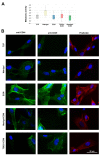Extracellular Matrix Synthesis and Remodeling by Mesenchymal Stromal Cells Is Context-Sensitive
- PMID: 35163683
- PMCID: PMC8836208
- DOI: 10.3390/ijms23031758
Extracellular Matrix Synthesis and Remodeling by Mesenchymal Stromal Cells Is Context-Sensitive
Abstract
Matrix remodeling could be an important mode of action of multipotent mesenchymal stromal cells (MSC) in extracellular matrix (ECM) disease, but knowledge is limited in this respect. As MSC are well-known to adapt their behavior to their environment, we aimed to investigate if their mode of action would change in response to healthy versus pathologically altered ECM. Human MSC-derived ECM was produced under different culture conditions, including standard culture, culture on Matrigel-coated dishes, and stimulation with the pro-fibrotic transforming growth factor-β1 (TGFβ1). The MSC-ECM was decellularized, characterized by histochemistry, and used as MSC culture substrate reflecting different ECM conditions. MSC were cultured on the different ECM substrates or in control conditions for 2 days. Culture on ECM increased the presence of surface molecules with ECM receptor function in the MSC, demonstrating an interaction between MSC and ECM. In MSC cultured on Matrigel-ECM and TGFβ1-ECM, which displayed a fibrosis-like morphology, gene expression of collagens and decorin, as well as total matrix metalloproteinase (MMP) activity in the supernatant were decreased as compared with control conditions. These results demonstrated that MSC adapt to their ECM environment, which may include pathological adaptations that could compromise therapeutic efficacy.
Keywords: MSC-derived ECM; collagen; extracellular matrix (ECM); matrisome; matrix metalloproteinases (MMP); matrix remodeling; mesenchymal stromal cells (MSC); mode of action; tissue-inhibitors-of-matrix-metalloproteinases (TIMP).
Conflict of interest statement
The authors declare no conflict of interest.
Figures




Similar articles
-
An in vitro culture platform to study the extracellular matrix remodeling potential of human mesenchymal stem cells.Acta Biomater. 2023 Oct 15;170:376-388. doi: 10.1016/j.actbio.2023.08.035. Epub 2023 Aug 22. Acta Biomater. 2023. PMID: 37619896
-
In vitro study of matrix metalloproteinase/tissue inhibitor of metalloproteinase production by mesenchymal stromal cells in response to inflammatory cytokines: the role of their migration in injured tissues.Cytotherapy. 2009;11(5):559-69. doi: 10.1080/14653240903051541. Cytotherapy. 2009. PMID: 19551542
-
Reverse remodeling is associated with changes in extracellular matrix proteases and tissue inhibitors after mesenchymal stem cell (MSC) treatment of pressure overload hypertrophy.J Tissue Eng Regen Med. 2009 Feb;3(2):85-91. doi: 10.1002/term.137. J Tissue Eng Regen Med. 2009. PMID: 19065545
-
Matrix metalloproteinases: pathways of induction by bioactive molecules.Heart Fail Rev. 2004 Jan;9(1):53-61. doi: 10.1023/B:HREV.0000011394.34355.bb. Heart Fail Rev. 2004. PMID: 14739768 Review.
-
The role of TIMPs in regulation of extracellular matrix proteolysis.Matrix Biol. 2015 May-Jul;44-46:247-54. doi: 10.1016/j.matbio.2015.03.005. Epub 2015 Mar 21. Matrix Biol. 2015. PMID: 25805621 Review.
Cited by
-
Perspectives of Proteomics in Respiratory Allergic Diseases.Int J Mol Sci. 2023 Aug 18;24(16):12924. doi: 10.3390/ijms241612924. Int J Mol Sci. 2023. PMID: 37629105 Free PMC article. Review.
-
Key Genes Identified in Nonsyndromic Microtia by the Analysis of Transcriptomics and Proteomics.ACS Omega. 2022 May 13;7(20):16917-16927. doi: 10.1021/acsomega.1c07059. eCollection 2022 May 24. ACS Omega. 2022. PMID: 35647449 Free PMC article.
-
Mesenchymal stromal cells in hepatic fibrosis/cirrhosis: from pathogenesis to treatment.Cell Mol Immunol. 2023 Jun;20(6):583-599. doi: 10.1038/s41423-023-00983-5. Epub 2023 Feb 24. Cell Mol Immunol. 2023. PMID: 36823236 Free PMC article. Review.
-
Progress of mesenchymal stem cells affecting extracellular matrix metabolism in the treatment of female stress urinary incontinence.Stem Cell Res Ther. 2025 Feb 25;16(1):95. doi: 10.1186/s13287-025-04220-w. Stem Cell Res Ther. 2025. PMID: 40001265 Free PMC article. Review.
-
Mesodermal Derivatives of Pluripotent Stem Cells Route to Scarless Healing.Int J Mol Sci. 2023 Jul 26;24(15):11945. doi: 10.3390/ijms241511945. Int J Mol Sci. 2023. PMID: 37569321 Free PMC article. Review.
References
-
- Matas J., Orrego M., Amenabar D., Infante C., Tapia-Limonchi R., Cadiz M.I., Alcayaga-Miranda F., González P.L., Muse E., Khoury M., et al. Umbilical Cord-Derived Mesenchymal Stromal Cells (MSCs) for Knee Osteoarthritis: Repeated MSC Dosing Is Superior to a Single MSC Dose and to Hyaluronic Acid in a Controlled Randomized Phase I/II Trial. Stem Cells Transl. Med. 2019;8:215–224. doi: 10.1002/sctm.18-0053. - DOI - PMC - PubMed
-
- Boberg E., von Bahr L., Afram G., Lindström C., Ljungman P., Heldring N., Petzelbauer P., Garming Legert K., Kadri N., Le Blanc K. Treatment of chronic GvHD with mesenchymal stromal cells induces durable responses: A phase II study. Stem Cells Transl. Med. 2020;9:1190–1202. doi: 10.1002/sctm.20-0099. - DOI - PMC - PubMed
MeSH terms
Substances
Grants and funding
LinkOut - more resources
Full Text Sources
Research Materials
Miscellaneous

